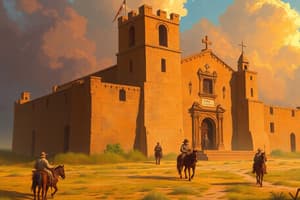Podcast
Questions and Answers
Who was Juan Ponce de Leon?
Who was Juan Ponce de Leon?
- Catholic rival for the English throne
- French explorer in Nova Scotia
- English explorer who circumnavigated the globe
- Spanish Explorer who discovered Florida (correct)
What are Huguenots?
What are Huguenots?
French Protestants influenced by John Calvin
Who was Sir Francis Drake?
Who was Sir Francis Drake?
English explorer/pirate who circumnavigated the globe
What does Apalachee refer to?
What does Apalachee refer to?
What is Camino Real?
What is Camino Real?
Who was Juan de Onate?
Who was Juan de Onate?
What is Santa Fe known for?
What is Santa Fe known for?
What was the Reformation?
What was the Reformation?
What is the Black Legend?
What is the Black Legend?
Who was Bartolome de Las Casas?
Who was Bartolome de Las Casas?
What does the Northwest Passage refer to?
What does the Northwest Passage refer to?
Who was Samuel de Champlain?
Who was Samuel de Champlain?
What is the significance of wampum?
What is the significance of wampum?
What was the Treaty of Tordesillas?
What was the Treaty of Tordesillas?
Who were the Metis?
Who were the Metis?
What is mercantilism?
What is mercantilism?
What was the Great Migration?
What was the Great Migration?
Who was John Winthrop?
Who was John Winthrop?
What was John Smith's contribution to Jamestown?
What was John Smith's contribution to Jamestown?
What was the outcome of the Starving Time?
What was the outcome of the Starving Time?
What does the House of Burgesses represent?
What does the House of Burgesses represent?
Flashcards are hidden until you start studying
Study Notes
Spanish Explorations
- Juan Ponce de Leon was a Spanish explorer who discovered and named Florida while searching for the mythical "Fountain of Youth."
- Juan de Onate served as a Spanish Conquistador in New Mexico, known for the brutal Acoma Pueblo uprising where over 800 Native Americans were killed.
- Situated in the Southwest, Santa Fe became the first permanent European settlement, though the Spanish struggled to establish dominance in the region.
Religious Influences
- Huguenots were French Protestants, significantly influenced by theologian John Calvin, who spurred the Reformation, a 16th-century movement that led to the establishment of Protestant churches.
- Bartolome de Las Casas was a Dominican priest advocating against the mistreatment of Native Americans, highlighting ethical concerns during the colonization.
Indigenous Tribes
- The Apalachee were one of the most powerful tribes in Florida during the Spanish contact era.
- The Huron were a matriarchal Iroquoian-speaking group in the St. Lawrence region, heavily impacted by smallpox carried by French traders.
Colonial Establishments
- Samuel de Champlain established Quebec, the first permanent French settlement in North America, and founded Port Royal, one of Canada's earliest settlements.
- New Netherland, a Dutch colony that later became New York, was influenced by legal philosopher Hugo Grotius, who argued that Native Americans had natural rights.
Trade and Economy
- The Camino Real was a significant Spanish royal road connecting missions in Florida.
- Wampum, polished seashell belts, served as a medium of trade and gift-giving among Native American tribes, particularly the Iroquois.
- The headright policy in Virginia granted land to settlers, incentivizing migration by offering 50 acres for each additional person they brought.
Political Developments
- The Treaty of Tordesillas established a boundary between Spanish and Portuguese claims in the Americas.
- Richard Hakluyt argued for exploration and colonization by England, suggesting it would offer economic opportunities and help relieve unemployment.
Conflicts and Disappearances
- Roanoke Island, established by Sir Walter Raleigh, mysteriously vanished, leaving only the word "CROATAN" as a clue.
- The "Starving Time" in Jamestown (1609-1610) resulted in the death of most colonists due to inadequate survival skills.
Major Figures
- Elizabeth I played a crucial role in overseeing England's golden age and maintaining Protestantism.
- John Smith was instrumental in Jamestown's survival through his leadership, while John Rolfe's successful tobacco cultivation established Virginia's economic foundation.
- Pocahontas, daughter of Chief Powhatan, married John Rolfe, improving relations between Native Americans and English settlers.
Societal Dynamics
- The House of Burgesses, created in 1618, marked the establishment of an elected assembly in colonial Virginia, limited to white landowners.
- Openchancanough, the brother of Powhatan, led efforts against colonial expansion in Virginia, resulting in a significant conflict in 1622.
Migration and Settlement
- The Great Migration saw about 20,000 people migrate to New England due to King Charles I's suppression of Puritan views.
- John Winthrop became the first governor of the Massachusetts Bay Colony, envisioning it as a "city upon a hill," reflecting Puritan ideals.
Studying That Suits You
Use AI to generate personalized quizzes and flashcards to suit your learning preferences.




